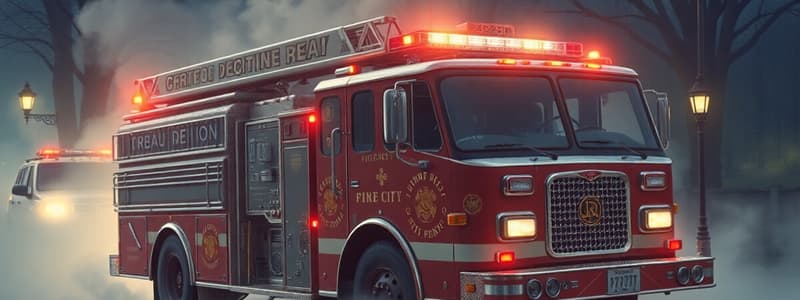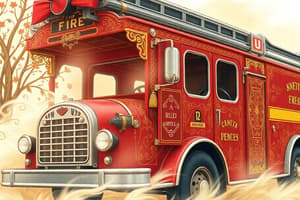Podcast
Questions and Answers
Who is responsible for reviewing the LMTV guideline annually?
Who is responsible for reviewing the LMTV guideline annually?
- All personnel of the Spring Fire Department
- The Fire Chief or designee (correct)
- The Safety Officer
- SFD Emergency Vehicle Technician
What condition requires the LMTV to be inspected and readied for service?
What condition requires the LMTV to be inspected and readied for service?
- Watch condition issued by the national weather service (correct)
- Routine Service Schedule
- General Maintenance Check
- Severe Weather Advisory
What does LMTV stand for?
What does LMTV stand for?
- Light-Medium Tactical Vehicle
- Light-Medium Technology Vehicle
- Light-Medium Transport Vehicle
- Light-Medium Transportation Vehicle (correct)
What is indicated by the CTIS OVRSPD light on the LMTV's dash panel?
What is indicated by the CTIS OVRSPD light on the LMTV's dash panel?
Before operating the LMTV, what must be completed according to the guideline?
Before operating the LMTV, what must be completed according to the guideline?
What should be used when deploying the rescue ramp?
What should be used when deploying the rescue ramp?
What is the maximum water depth for using the LMTV in rescue incidents?
What is the maximum water depth for using the LMTV in rescue incidents?
What should be done prior to entering water with the LMTV?
What should be done prior to entering water with the LMTV?
What must be done after the LMTV is used in water?
What must be done after the LMTV is used in water?
Who needs to be contacted after the LMTV is used in water?
Who needs to be contacted after the LMTV is used in water?
What tire pressure does the Cross Country mode select?
What tire pressure does the Cross Country mode select?
What is the maximum speed limit for the Sand mode?
What is the maximum speed limit for the Sand mode?
What must be completed prior to the deployment of the LMTV?
What must be completed prior to the deployment of the LMTV?
Who must respond whenever the LMTV is deployed for emergency response?
Who must respond whenever the LMTV is deployed for emergency response?
Which mode should be selected for the highest speed?
Which mode should be selected for the highest speed?
How long can the Emergency mode be operated?
How long can the Emergency mode be operated?
What must all SFD personnel do when the LMTV is in use without evacuees?
What must all SFD personnel do when the LMTV is in use without evacuees?
Which of the following is required for personnel operating the LMTV in water over 6” deep?
Which of the following is required for personnel operating the LMTV in water over 6” deep?
What happens if the vehicle exceeds the speed limit for the selected mode?
What happens if the vehicle exceeds the speed limit for the selected mode?
Which mode should be utilized when the LMTV is on an improved road?
Which mode should be utilized when the LMTV is on an improved road?
What should be verified before activating a mode of travel?
What should be verified before activating a mode of travel?
What tire pressure does the Sand mode utilize?
What tire pressure does the Sand mode utilize?
What is the purpose of the 'HWY' mode in the LMTV?
What is the purpose of the 'HWY' mode in the LMTV?
Which mode is preferred when no other modes have been used?
Which mode is preferred when no other modes have been used?
Which personnel are required to be familiar with LMTV operations?
Which personnel are required to be familiar with LMTV operations?
What speed does the HWY mode govern the LMTV to while in operation?
What speed does the HWY mode govern the LMTV to while in operation?
Study Notes
Spring Fire Department LMTV Guidelines
-
Purpose: Define guidelines for Spring Fire Department personnel regarding the deployment and use of the LMTV (Light-Medium Transportation Vehicle).
-
Scope: Applicable to all Spring Fire Department personnel.
-
Responsibilities:
- All personnel are responsible for knowing and complying with the guidelines.
- Fire Chief or designee reviews the guidelines annually for accuracy.
-
Definitions:
- LMTV: Light-Medium Transportation Vehicle
- CTIS: Central Tire Inflation System
- CTIS OVRSPD: Amber warning light indicating vehicle speed exceeds the safe limit for selected tire inflation pressure
- Radiator Fan Cut-Off: Disables the radiator fan activation.
- Watch: 36-hour period before inclement weather.
- Warning: 24-hour period before inclement weather.
- Improved Roadway: Street or commercially constructed lane of traffic for daily use by vehicles.
- Unimproved Roadway: Area of sand, dirt, clay, crushed concrete, or natural vegetation not designed for vehicle travel.
Pre-Operation Checks
- All LMTV operation requires completing the vehicle checklist, reporting any discrepancies to an SFD Emergency Vehicle Technician.
- Upon issuing a "Watch" condition by the National Weather Service, an SFD Emergency Vehicle Technician prepares the LMTV for service.
- Upon issuing a "Warning" condition by the National Weather Service, potential LMTV drivers watch an operational video at the provided link.
- Before deploying the LMTV, complete the Pre-Deployment checklist.
- An SFD Emergency Vehicle Technician or designee, in coordination with the SFD Command Staff, delivers the LMTV to the affected area’s station.
LMTV Operators
- The on-duty District Chief responds during any emergency deployment of the LMTV.
- All SFD personnel must wear seat belts while the LMTV is in use, including evacuees.
- The SFD attendant in the rear of the vehicle ensures all passengers are seated as close to the front of the bed as possible.
- Approved operators must attend an LMTV lecture/training course and complete the driving/operations course.
- Only approved operators can drive/operate the LMTV.
- The second and third members of the LMTV crew should be familiar with operations but are not required to be approved operators.
- When operating the LMTV in water exceeding 6 inches, all personnel must wear a SFD-supplied PFD, SFD-provided rescue helmet, and class "C" uniform (pants preferred) or an approved wet suit.
LMTV Usage
- The LMTV should always be operated safely and professionally.
- Preferred operation on improved roads, maintaining a speed minimizing wake production.
- On improved roads, the "HWY" mode should be selected, setting tire pressure to 55 psi and limiting speed to 55 mph.
- For unimproved roads, two additional modes on the CTIS can be selected:
- "X_C" (Cross Country) mode for mixed terrain, deflating tire pressure to 33 psi and limiting speed to 40 mph.
- "Sand" (Soft Terrain) mode for mud, large areas of vegetation, and unimproved roads, reducing tire pressure to 20 psi and limiting speed to 12 mph.
- Ensure the LED for the selected CTIS mode is fully illuminated and not flashing, indicating the mode is operational.
- Use "HWY" mode after using other modes during an incident.
- Operating mode restrictions:
- Highway: 55 mph, no time restriction, 55 psi.
- Cross-Country: 40 mph, no time restriction, 33 psi.
- Sand: 12 mph, no time restriction, 20 psi.
- Emergency: 5 mph, 10-minute time restriction, 14 psi.
- An amber warning light in the instrument cluster illuminates when exceeding the speed limit for the selected driving mode (CTIS OVER SPEED). Either reduce speed or select a different mode.
- The service drive lights are in an oval switch panel on the right side of the instrument panel.
- Use utility gloves when deploying the rescue ramp.
- Additional lighting illuminates the area while personnel or citizens occupy the LMTV bed.
- Do not use the LMTV in water deeper than 30 inches.
- Turn off the radiator fan before entering water (upper left of the instrument panel).
- Re-engage the fan after exiting water or when the water level drops below 10 inches.
- Primarily use the vehicle for rescuing people, not belongings.
- After use, wash the LMTV, completely rinse the undercarriage, clear debris, contact an SFD Emergency Vehicle Technician for proper PM procedures after water use.
Studying That Suits You
Use AI to generate personalized quizzes and flashcards to suit your learning preferences.
Related Documents
Description
This quiz covers the guidelines for the deployment and use of the Light-Medium Transportation Vehicle (LMTV) within the Spring Fire Department. It includes definitions of key terms, responsibilities of personnel, and the scope of the guidelines. Ensure that you are familiar with these important protocols for safety and efficiency.



